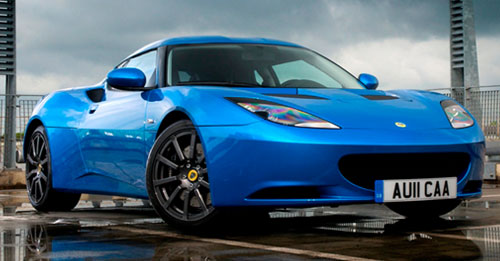2013 Lotus Evora S IPS
Doing a lot with a little has been a way of life at Lotus over its entire 60 year history. Whether it’s cutting weight or taking Toyota engines to the max, Lotus continues to impress with their brilliantly miserly ways. Well their latest reduction is the removal of the clutch pedal from their 2+2 Evora sports car. So let’s hit the track and find out if paddle shifts make the new Evora an automatic winner.
In many ways a car’s transmission is its personality. It can be needy, requiring constant involvement; or it can be self-reliant, taking care of gear selection on its own. So a change in transmission, as we find here in the 2013 Lotus Evora S, has the potential to alter its personality and thus change the way we feel about the car as a whole.
Well, we couldn’t think of a better place to get acquainted with this new paddle shift Evora, the first example in the country, than Roebling Road Raceway. Just two years ago we put the original Evora through its paces here and found that its thrilling track performance combined with its gentile street nature to make it the most complete Lotus yet.
The new 6-speed automatic transmission in question is Toyota’s U660E, but with Lotus’s own software. The Intelligent Precision Shift transmission has 4-modes of operation and comes with its paddle shifters mounted with the steering wheel rather than in a fixed position on the column. There’s no traditional shifter at all, just buttons for park, neutral, reverse, and drive. How it works on the track is fairly sound. Not so fine that we’d prefer it over the manual, but in sport mode, shifts are suitably brisk, and in manual mode you do have full control as well as rev-matching on corner entry downshifts.
 It also works well in a straight line, though on a very cold track, we recorded a 0-60 time of 4.6-seconds. That’s 3-tenths slower than the Evora S manual. It made some of that up with quicker gear changes and is only 2-tenths slower in the quarter-mile at 13-flat and 106 miles-per-hour. The auto does add some weight, inching the Evora S closer to 3,200 pounds, but you won’t notice it.
It also works well in a straight line, though on a very cold track, we recorded a 0-60 time of 4.6-seconds. That’s 3-tenths slower than the Evora S manual. It made some of that up with quicker gear changes and is only 2-tenths slower in the quarter-mile at 13-flat and 106 miles-per-hour. The auto does add some weight, inching the Evora S closer to 3,200 pounds, but you won’t notice it.
Nothing changes when it comes to suspension or brakes, so there’s nothing new to add to the praises we’ve previously sung about the willing chassis that gives you a ton of feel and fun through corners or the crazy late braking that you can do into them. Not that any changes were needed. A superlight nature with just enough power, makes for the perfect track experience; and the Evora’s easy to master temperament, makes getting up to speed in a hurry no problem.
The exterior also carries over unchanged, which can be a plus or minus depending on how you feel about the Evora’s aerodynamically sleek and silky look. But, we all agree it looks much better at speed on a track than sitting still. Our test car’s Laser Blue paint job with gun-metal finished alloy wheels is certainly a good combo, with the 19-inch fronts and 20-inch rears, wearing Pirelli P-Zero Corsa tires, replacing the stock 18/19 combo.
The large, front air intake combines with hood vents and side vents to manage airflow. It’s by no means a large vehicle, but from the rear, it looks downright tiny. It also appears very serious, with the floating wing and central mounted exhaust nicely integrated. Brake discs are ventilated and cross-drilled with slightly larger 13.8-inch rotors up front.
 Inside, the same basic interior showcases Lotus’s business first approach with tight confines and race inspired gauges; but with optional Premium and Tech Packages, it offers enough creature comforts to make sports care savvy buyers more than happy.
Inside, the same basic interior showcases Lotus’s business first approach with tight confines and race inspired gauges; but with optional Premium and Tech Packages, it offers enough creature comforts to make sports care savvy buyers more than happy.
Under the hood, or rather beneath the rear hatch, is the same Toyota Camry-based 3.5-liter supercharged V6 as before, cranking out 345-horsepower and 295 lb-ft. of torque. And there is a small amount of storage space behind it, though things tend do to get pretty heated back there. Just one more motivation to make that trip back from the grocery store as fast as possible.
Away from the track, the Evora remains a very comfortable car to drive, and now it’s gotten easier to deal with sitting in traffic thanks to the automatic transmission. Another bonus, fuel economy improves to 19-City, 28-Highway, and 22-Combined; making the Energy Impact Score 15.0-barrels of oil consumed per year with CO2 emissions of 6.6-tons.
The IPS transmission is a $2,850 option added to the Evora S base price of $80,085. You can have almost as much fun without the supercharger in a base Evora, which begins at $69,785. And you can save a few bucks further by eliminating the rear seat.
Well, after a week of thoroughly flogging this automatic equipped 2013 Lotus Evora S on the track and putting in some commute time on the streets, we feel this new personality fits right in; and makes the already most complete Lotus ever… even more complete.
Specifications
- Engine: 3.5-liter
- Horsepower: 345
- Torque: 295 lb-ft.
- 0-60 mph: 4.6 seconds
- 1/4 mile: 13 seconds @ 106 mph
- EPA: 19 mpg city/ 28 mph highway
- Energy Impact: 15.0 barrels of oil/yr
- CO2 Emissions: 6.6 tons/yr






